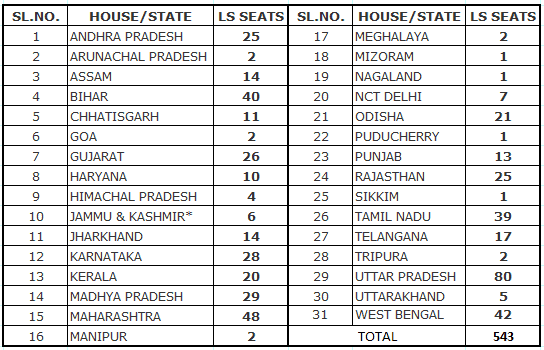In 2014, the BJP-led NDA’s victory over the Congress-led UPA was the outcome of few factors: Modi’s enigmatic personality; elegant social engineering; aggressive on-ground management of the election process and a persuasive narrative showcasing the downsides of the United Progressive Alliance (mainly corruption and misconduct of the economy) and the pledge of the alternative (economic growth and employment).
Now, in the eve of general election 2019, the Congress is trying to form a strategic coalition with several regional parties in a united bid to defeat BJP and NDA as a whole. However, according to a top Congress member, the party will leave it to the poll outcome to help build a consensus on the prime ministerial candidature.
If state-wise seats for the Lok-Sabha Election is being considered, it is clear that majority of the seats are distributed within some key states, which the congress is eyeing on. Despite of running BJP government, Congress believes that BJP may lose a major chunk of its seats in Uttar Pradesh (UP), Maharashtra and Bihar, if proper opposition alliance could be firmed, which eventually would pave the way for its victory.
In this regard, the Congress wants to work out a ‘broad strategic understanding’ and ‘and details of seat-sharing’ among Samajwadi Party (SP), Bahujan Samaj Party (BSP) and them in politically important Uttar Pradesh, which sends 80 MPs to the Lok Sabha. On the other hand, in Maharashtra, Congress is already in allegiance with National Congress Party (NCP), but will not ally with parties like Shiv Sena whose ideology is not in consonance with its own philosophy. The Congress has to shake hand with Rashtriya Janata Dal (RJD) and Loktantrik Janata Dal (LJD) in Bihar as the former partner JDU’s Nitish Kumar has shown his allegiance with NDA and also suffers serious credibility crisis.
Nonetheless, in case of Chhattisgarh, Rajasthan and Madhya Pradesh, three states which contributed 65 out of 65 seats to the BJP in 2014 election would exude with a major chunk of seats if the Congress remains in contest alone anticipating unrest within the public against BJP government. A trailer of this anticipation is expected to be reflected in the upcoming state election. ‘The party will focus on selection of right candidates for these elections and run a proper campaign,’ as per sources. Whereas in West Bengal, Congress is going to contest in very restricted seats while maintaining alliance with Trinamool Congress (TMC). Meanwhile, Andhra Pradesh’s Chief Minister N. Chandrababu Naidu with his 16 MPs unexpectedly deluged to the UPA team.
According to sources, Congress is setting a two-stage action plan for the 2019 general elections, under which it will first bring on board all opposition parties and form a ‘Grand Alliance’ to defeat Modi and the BJP/RSS and then decide on the leadership issue on the basis of election results. The Congress is considering the leadership issue to be counter-productive in post-poll circumstances and may be divisive for the opposition coalition. A Congress spokesperson also added that, ‘it would be acrimonious for the opposition unity and would unwarrantedly serve the BJP agenda.’
So, it is perceptible that the Congress has to forge alliances for interim goals in various states; meanwhile it has to be aggressive enough to grab the opportunity to reinforce its base as well as remain its entity as the main opponent in the parliament. If the party yields more space for the ‘Grand Alliance’ and ends up contesting less than 350 seats, it will be difficult for it to secure the required 150 seats to block the BJP’s claims and to structure a firm alliance. The party has to work for a vision to oust the BJP government from power by setting the narrative in the run-up to 2019 election highlighting the failure of the NDA on issues like- job creation, unsuccessful economic growth, plight of farmers, rocketing petrol price, devaluation of money with respect to USD etc.
In this circumstance of growing opposition unity, PM Modi delivered a delicate speech in the parliament during a no-confidence motion, where he havocked his attack over the Congress, but tactfully abstained from being offensive towards the regional forces. This indicates that Modi is respecting the strength of the regional parties and conveying them indications that the BJP is prepared to accommodate them in NDA. Meanwhile, BJP has to especially reconsider its strategy to revive Uttar Pradesh Chief Minister Yogi Adityanath’s (BJP) waning popularity and simultaneously fade the integrity dilemma of Bihar Chief Minister Nitish Kumar (JDU-ally of BJP) as those two states played a major role for BJP’s massive win in 2014 by ensuring 104/120 seats.
Credit Image: OutlookIndia







